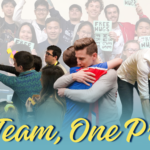No one likes being the new kid. You don’t know the rules. You don’t know anyone. The group cliques are already made. Your broken glasses are taped up, and your hand-me-down farm overalls barely fit anymore.
Oh, is that just me? Anyways…”
Being new to a community is challenging. However, onboarding new members is critical to their engagement and retention within your team, organization, or community.
Leaders can do three critical things during onboarding to help new members feel welcomed, connected, and engaged. In our world, we call this building a Culture of Connection™.
And by ‘Culture of Connection™,’ I don’t mean making everyone wear friendship bracelets and sing Kumbaya. Although…
Did you know that research shows that students’ habits during their first 90 days of college will drastically impact their behavior for the next 3.5 years of college? This explains why those of you who spent your first 90 days learning to make ramen in a coffee pot ate that same meal for the rest of your college career.
Colleges know this, so they spend a lot of money on activities to help students develop positive habits during the first 90 days of their experience.
The same principle applies to any new job, fitness club, or online community—minus the ramen-cooking thing. The initial experience can make or break a person’s commitment and overall satisfaction.
According to a study by the Brandon Hall Group, organizations with a strong onboarding process improve new hire retention by 82% and productivity by over 70%. That’s not just impressive; it’s transformative.
On the flip side, only 17% of employees were satisfied with their onboarding process, and 50% of employees who left the organization within two years cited a poor onboarding experience as part of their reason for leaving.
Before I get started on the crazy costs associated with employee turnover, let’s nip it in the bud by showing you the three things every leader should do during the onboarding process to make sure your new people feel like this is their place for the long term.
ACTION 1 – Personalized Welcome
First, let’s talk about personalized welcome. Imagine walking into a room where nobody knows your name versus one where you’re greeted by your name with a warm smile. It feels different, right? That’s the power of personalization.
But it doesn’t have to wait until they attend an event. It should start as soon as they sign up. For new members, receiving a personalized welcome message, whether an email, a video, or a small welcome package, can make a big difference. It shows them that they are not just another number but a valued part of the community.
Take it further by highlighting something unique about them or how their skills and interests align with the group’s goals. This immediate recognition can significantly boost their sense of belonging and commitment.
I once joined a community and, within an hour, was sent a personalized video welcoming me. Then, a week later, I got a welcome package in the mail! That was seven years ago. And guess what? I’m still a member today.
ACTION 2 – Content Training on Rules and Roles
Next, we have Content Training on Rules and Roles. New members must understand the lay of the land as soon as possible. This means providing clear, accessible information about the community’s rules, expectations, and how things operate.
But it’s not just about dos and don’ts; it’s also about empowering them with knowledge about their role and how they can contribute. Consider creating an engaging onboarding module or a mentorship program where newbies can learn the ropes from the veterans. This clarifies their role within the community and sets them up for success from day one.
As you develop this, remember that every community has official and unofficial rules. For example, you should contribute to discussions. Unofficially, don’t reply to every email with ‘Thanks.’
What are your community’s unofficial rules and traditions, and how can you build those into your training?
ACTION 3 – Social Connections
Finally, focus on Building Social Connections. Humans are social creatures, and feeling connected is a fundamental need. Facilitate opportunities for new members to forge meaningful connections within the community.
This could be through welcome events, interest-based groups, or buddy systems. Encouraging interaction in a relaxed, social setting can help new members find their tribe within the larger community. That data shows that when people feel connected, their loyalty, engagement, productivity, and satisfaction levels skyrocket.
As we close out, some of you are still wondering if you should put extra effort into creating a great onboarding experience. Well, the answer is YES!
Think of it as an investment. It is like buying stocks, but instead of stocks, it’s people. And instead of dividends, you get a thriving community. Actually, it’s nothing like buying stocks.
Overwhelming yes! 69 percent of employees are likelier to stay with a company for three years if they experience great onboarding. The goal of onboarding isn’t just to inform; it’s to transform. It’s about turning that overwhelming feeling of being the “new kid” into a sense of excitement and belonging. Focusing on a Personalized Welcome, Content Training on Rules and Roles, and Building Social Connections lays the foundation for a thriving, engaged community.
And let’s remember, a community that grows together stays together.
So, take these steps to heart, and let’s make every new member’s onboarding experience not just good but great. Because at the end of the day, the strength of a community is measured not by the number of members it has but by the number of members who feel like they truly belong.




